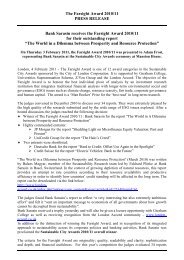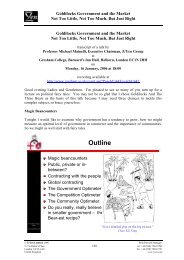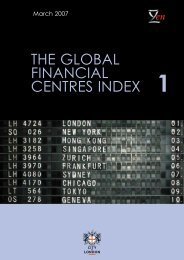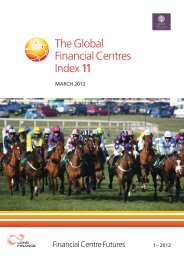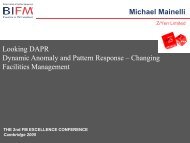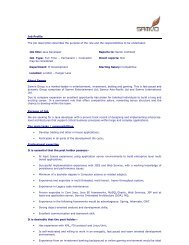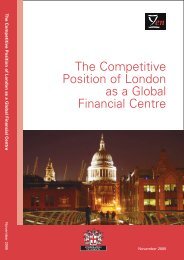The global financial centres index (GFCI) 3 - Z/Yen
The global financial centres index (GFCI) 3 - Z/Yen
The global financial centres index (GFCI) 3 - Z/Yen
You also want an ePaper? Increase the reach of your titles
YUMPU automatically turns print PDFs into web optimized ePapers that Google loves.
<strong>The</strong> Global Financial Centres Index<br />
Corporate Tax Rates, OECD (September 2007) 1<br />
– <strong>The</strong> OECD provides annual figures of Central<br />
Government Corporate Income Tax Rates. <strong>The</strong><br />
basic rate (inclusive of surtax) is used and<br />
adjusted to show the net rate where the<br />
central government provides a deduction in<br />
respect of sub-central income tax.<br />
Source: www.oecd.org<br />
Employee Effective Tax Rates, PwC (July 2007) 1<br />
– <strong>The</strong> tax rates were calculated by dividing the<br />
net compensation for each city by its gross<br />
compensation. PwC provided specific figures<br />
for the <strong>GFCI</strong> based on a more typical <strong>financial</strong><br />
service employee.<br />
Wage Comparison Index, UBS (September<br />
2006) – A study comparing gross and net<br />
wages of workers across 71 cities, using New<br />
York as the base city (with an <strong>index</strong> of 100).<br />
<strong>The</strong> indices were created using effective hourly<br />
wages for 14 professions, weighted according<br />
to distribution, net after deductions of taxes<br />
and social security. <strong>The</strong> <strong>GFCI</strong> uses the gross<br />
wage <strong>index</strong>.<br />
Source: www.ubs.com<br />
Personal Tax Rates, OECD (September 2007) 1<br />
– <strong>The</strong> OECD provides annual figures of average<br />
personal income tax rates at average wages,<br />
by family type. For the purposes of this study,<br />
the all-in rate (a combination of central and<br />
sub-central government income tax, plus<br />
employee social security contribution, as a<br />
percentage of gross wage earnings) for a<br />
single person with no children was used.<br />
Source: www.oecd.org<br />
Total Tax Receipts (As a Percentage of GDP),<br />
OECD (September 2007) 1 – <strong>The</strong> statistics are<br />
taken from the taxation table in the report<br />
OECD in Figures.<br />
Source: www.oecd.org<br />
Ease of Doing Business Index, World Bank<br />
(November 2007) 1 – A ranking was given to<br />
175 economies based on their ease of doing<br />
business. A high ranking indicates that the<br />
regulatory environment is conducive to the<br />
operation of business. <strong>The</strong> <strong>index</strong> averages the<br />
country's percentile rankings on ten topics,<br />
made up of a variety of indicators, giving<br />
equal weight to each topic.<br />
Source: www.doingbusiness.org<br />
Opacity Index, Kurtzman Group (Latest<br />
Available) – 65 objective variables<br />
from 41 sources are used to obtain the <strong>index</strong>,<br />
which is a score between 0 and 100,<br />
calculated by averaging the scores given<br />
to each of five sub-indices (corruption,<br />
efficacy of legal system, deleterious<br />
economic policy, inadequate<br />
accounting/governance practices and<br />
detrimental regulatory structures).<br />
Source: www.opacity<strong>index</strong>.com<br />
Corruption Perceptions Index, Transparency<br />
International (September 2007) 1 – Expert<br />
assessments and opinion surveys are used to<br />
rank more than 150 countries by their<br />
perceived levels of corruption. Data were<br />
gathered from sources spanning the last three<br />
years.<br />
Source: www.transparency.org<br />
Index of Economic Freedom, Heritage<br />
Foundation (June 2007) 1 – A study of 161<br />
countries against a list of 50 independent<br />
variables divided into ten broad factors of<br />
economic freedom. <strong>The</strong> higher the score on a<br />
factor, the greater the level of government<br />
interference in the economy and the less<br />
economic freedom a country enjoys.<br />
Source: www.heritage.org<br />
Economic Freedom of the World Index, Fraser<br />
Institute (September 2006) 1 – This is a joint<br />
venture involving seventy-one research<br />
institutes in seventy-one countries around the<br />
world. <strong>The</strong> <strong>index</strong> is divided into five<br />
components – size of government, legal<br />
structure/security of property rights, access to<br />
sound money, freedom to trade<br />
internationally and regulation of credit, labour<br />
and business.<br />
Source: www.freetheworld.com<br />
Financial Markets Index, Maplecroft (January<br />
2007) – Scores were given to countries based<br />
on their specific risks to <strong>financial</strong> system<br />
stability over a short-term <strong>financial</strong> investment<br />
time horizon. <strong>The</strong> <strong>index</strong> focuses on five<br />
different types of risk – economic, sovereign,<br />
69




